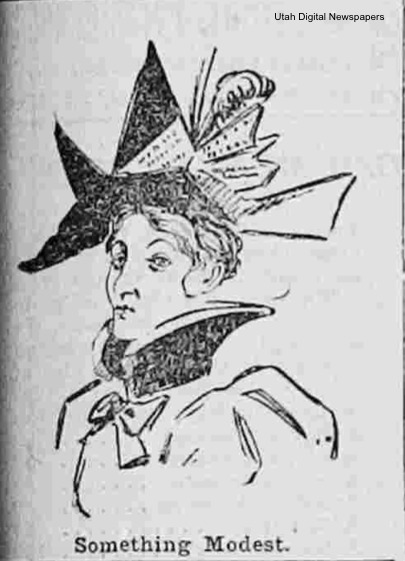Dublin Core
Title
Description
Before the days of social media and television, late 19th century Utahns frequented theaters for their entertainment. But the absolute worst experience you could have at the theater – so it goes – was sitting behind someone with an obnoxiously large hat. For this reason, one of the first laws Utah passed as a newly-minted state restricted large headwear in theaters and fined violators between $1 and $10 dollars. Called the “High Hat Law,” the ban was written by one of the first-ever female legislators, Eurithe K. La Barthe.
La Barthe’s law was passed for good reason. Big hats in Salt Lake theaters caused many complaints, but sometimes sexism about women’s fashion compounded the grumbling. Although men wore tall top-hats, they were not targeted by the law the way women were. One Salt Lake Tribune article from 1897 mocked the growing size and decoration on women’s hats, as well as the women who bought them. In the article, a bonnet maker told the reporter “we work with hands and brains to fit the outside of the feminine head – but the inside, oh! it’s hard to fit – sometimes there is nothing in it.”
This kind of sexism about fashion also bled into the hat law itself, and La Barthe faced a lot of opposition as one of the country’s first female politicians. She wrote and passed Utah’s High Hat Law in 1897 – a huge feat given that female suffrage wouldn’t be nationally granted for another 23 years. But critics raised questions from the start, calling it a “freak law” that addressed a superfluous issue only a woman politician would think to care about.
Just after the High Hat Law was passed, the Salt Lake Tribune reported from the Salt Lake Theater in 1897 that “a number of ladies were defying the majesty of the law” with “several one-story summer-cottage creations… Just how many ostriches had been stripped to supply these mammoth creations would be hard to tell.” By 1899, however, La Barthe’s law started working. Theaters inserted the text of the law itself into their programs and women regularly removed their artful head decorations before the show began.Creator
Source
_______________
See Jean Bickmore White, “Gentle Persuaders Utah's First Women Legislators,” Utah Historical Quarterly, Volume 38, Number 1, 1970; “Rush for Spring Hats,” Salt Lake Tribune, March 28, 1897; “Theatrical,” Salt Lake Tribune, January 1, 1899; “Hat Law Violated,”Salt Lake Tribune. February 20, 1897; “Nuisances in Theatres,” Salt Lake Herald-Republican, February 2, 1897; “General Items,” Broad Ax, May 29, 1897; “Famous Woman is Dead in Zion,” Salt Lake Tribune, November 23, 1910; “The Ohio Hat,” Salt Lake Herald-Republican, April 13, 1896; Eurithe K. LaBarthe, Author of the “High Hat Law,”Better Days 2020 Curriculum, accessed November 2022.

